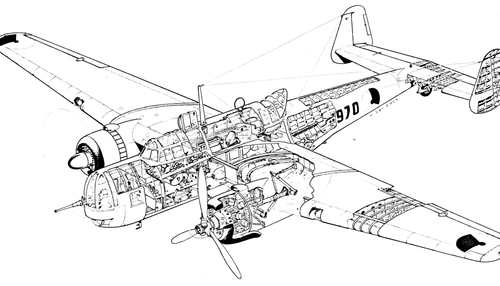a beatiful airplane ! 
"Based on the experience gained in creating TV medium bomber and maritime reconnaissance T. VIII Fokker D department company in 1938 started to build aircraft with higher performance. Building of the first prototype began in 1939. The aircraft was built under the scheme svobodonesuschego monoplane with two engines, air-cooled, Bristol "Hercules" and retractable landing gear. The crew consisted of five persons. Armament aircraft housed in the fuselage - were established here, one 20-mm cannon and four defensive 7.7-mm machine guns (they are mounted on the pivot installations in three defensive points in the fuselage, but the prototype flew without armament). Bomb load reached 2000 kg.
September 10, 1939 T. IX first flew under test pilot firm Fokker T. J. Leegstra. The plane originally had the number 701, but on September 23, after delivery of the prototype to another airfield, number changed to 970. Tests of the prototype took place without major incidents, until March 8, 1940 while landing revealed a defect in the design of the chassis and T. IX was slightly injured. Before the German invasion completely renovate the aircraft did not have time. The bomber set in the hangar, waiting for the fighting in Holland. After the occupation of Holland, the Germans did not restore T.IX. Instead, they removed the engines and some aircraft units for their own needs. In "полуразобранном" a plane lived to the end of the war and was sent to the Aviation Museum in Gilze-Riyen, whence he was sent for scrap in 1960."
(Translation by Google Translator)
from
http://www.airwar.ru/enc/sww2/fokt9.html
"полуразобранном" : untranslated word
"Based on the experience gained in creating TV medium bomber and maritime reconnaissance T. VIII Fokker D department company in 1938 started to build aircraft with higher performance. Building of the first prototype began in 1939. The aircraft was built under the scheme svobodonesuschego monoplane with two engines, air-cooled, Bristol "Hercules" and retractable landing gear. The crew consisted of five persons. Armament aircraft housed in the fuselage - were established here, one 20-mm cannon and four defensive 7.7-mm machine guns (they are mounted on the pivot installations in three defensive points in the fuselage, but the prototype flew without armament). Bomb load reached 2000 kg.
September 10, 1939 T. IX first flew under test pilot firm Fokker T. J. Leegstra. The plane originally had the number 701, but on September 23, after delivery of the prototype to another airfield, number changed to 970. Tests of the prototype took place without major incidents, until March 8, 1940 while landing revealed a defect in the design of the chassis and T. IX was slightly injured. Before the German invasion completely renovate the aircraft did not have time. The bomber set in the hangar, waiting for the fighting in Holland. After the occupation of Holland, the Germans did not restore T.IX. Instead, they removed the engines and some aircraft units for their own needs. In "полуразобранном" a plane lived to the end of the war and was sent to the Aviation Museum in Gilze-Riyen, whence he was sent for scrap in 1960."
(Translation by Google Translator)
from
http://www.airwar.ru/enc/sww2/fokt9.html
"полуразобранном" : untranslated word


